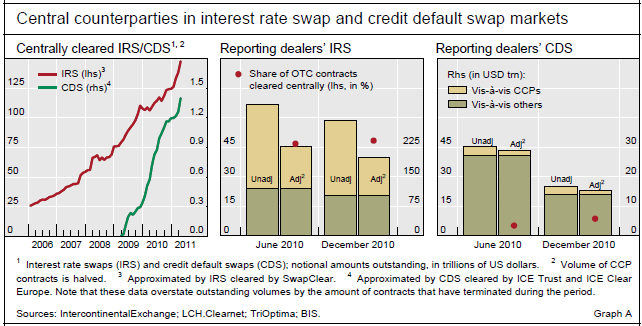Central clearing and OTC derivatives statistics
(Extract from page 26 of BIS Quarterly Review, June 2011)
The amount of OTC derivatives cleared centrally has increased considerably in recent years (Graph A, left-hand panel). This has implications for measuring the size of the OTC derivatives market. Central clearing doubles the outstanding volume of any OTC derivative to which it is applied. This is because it involves replacing a contract between two counterparties, say A and B, with one contract between A and a central counterparty (CCP) and a second contract between B and the CCP.1 In addition to these rather mechanical effects, clearing contracts centrally also affects volumes outstanding through the increased scope for multilateral netting and through the impact on traders' incentives. In this box, we focus on the direct impact on amounts outstanding.
While central clearing doubles the number of contracts, it does not change the volume of underlying risk that is being transferred by OTC derivatives. If the aim is to measure the size of this risk transfer, then it is appropriate to halve outstanding contract volumes with CCPs. It is also appropriate if the objective is to establish the volume or proportion of contracts in OTC derivatives markets that is centrally cleared.
However, if one is interested in counterparty risk, then the total volume of outstanding derivatives contracts, ie without halving the amounts cleared with CCPs, is the relevant figure. Although CCPs are intended to have very low default probabilities, these are not zero.2 It is therefore necessary to count all contracts to which they are a counterparty, along with all other contracts, when evaluating the total volume of counterparty risk in OTC derivatives markets. Graph A shows the growing importance of CCPs in OTC interest rate and credit derivatives markets and the effect that halving CCP positions can have on contract volumes in these markets.
1 For a fuller description of the mechanics of central clearing, see N Vause, "Counterparty risk and contract volumes in the credit default swap market", BIS Quarterly Review, December 2010.
2 For an investigation of the risk faced by CCPs, see D Heller and N Vause, "Expansion of central clearing", in this issue.


